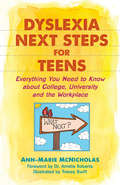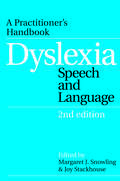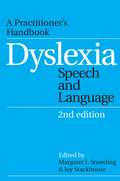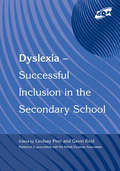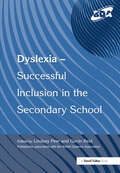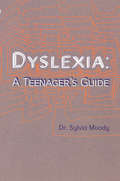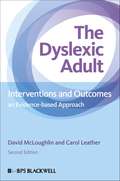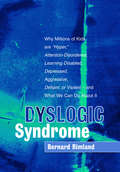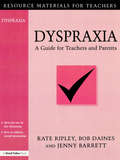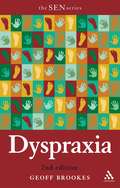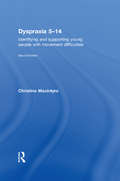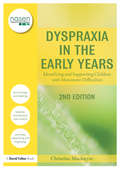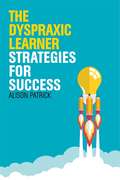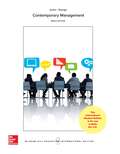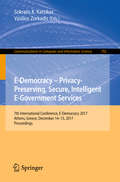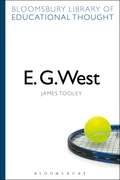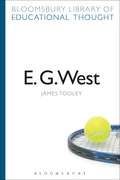- Table View
- List View
Dyslexia Next Steps for Teens: Everything You Need to Know about College, University and the Workplace
by Ann-Marie McNicholasWritten for 14+ year olds, this accessible book empowers young people with dyslexia to make a smooth transition to college, university or the workplace. An engaging and informative guide, it will help you plan and make decisions about the next stage of your education or employment.Ann-Marie McNicholas, who has worked with young people with dyslexia for many years, answers the questions that you will have as you plan for life at university or college. She covers the differences between school and college and university, lists the different types of dyslexia assessment available and gives you simple, tried-and-tested tips to help you to manage your time, your workload and your revision. Beyond information about further and higher education, the book is full of advice on preparing for the next stage in your life, such as moving into the workplace.A must-read pocket guide for teenagers with dyslexia and an essential resource for parents, teachers, SENCOs, career advisers, and anyone else involved in supporting learners with dyslexia to make a successful transition to further education and the world of work.
Dyslexia Next Steps for Teens: Everything You Need to Know about College, University and the Workplace
by Ann-Marie McNicholasWritten for 14+ year olds, this accessible book empowers young people with dyslexia to make a smooth transition to college, university or the workplace. An engaging and informative guide, it will help you plan and make decisions about the next stage of your education or employment.Ann-Marie McNicholas, who has worked with young people with dyslexia for many years, answers the questions that you will have as you plan for life at university or college. She covers the differences between school and college and university, lists the different types of dyslexia assessment available and gives you simple, tried-and-tested tips to help you to manage your time, your workload and your revision. Beyond information about further and higher education, the book is full of advice on preparing for the next stage in your life, such as moving into the workplace.A must-read pocket guide for teenagers with dyslexia and an essential resource for parents, teachers, SENCOs, career advisers, and anyone else involved in supporting learners with dyslexia to make a successful transition to further education and the world of work.
Dyslexia, Speech and Language: A Practitioner's Handbook (Dyslexia Series (Whurr))
by Margaret J. Snowling Joy StackhouseThis authoritative handbook presents current ideas on the relationship between spoken and written language difficulties. It provides clinical and educational perspectives on the assessment and management of children's reading and spelling problems. The book begins with a theoretical overview. The second edition continues the theme of linking theory and practice. It is aimed at practitioners in the fields of education, speech and language therapy, and psychology. All original chapters have been updated and new chapters are added to reflect current developments.
Dyslexia, Speech and Language: A Practitioner's Handbook
by Margaret J. Snowling Joy StackhouseThis authoritative handbook presents current ideas on the relationship between spoken and written language difficulties. It provides clinical and educational perspectives on the assessment and management of children's reading and spelling problems. The book begins with a theoretical overview. The second edition continues the theme of linking theory and practice. It is aimed at practitioners in the fields of education, speech and language therapy, and psychology. All original chapters have been updated and new chapters are added to reflect current developments.
Dyslexia-Successful Inclusion in the Secondary School
by Lindsay Peer Gavin ReidIncreasingly dyslexia is becoming a whole-school issue. The responsibility for addressing the needs of dyslexic students no longer rests with one individual but is the responsibility of all school staff - subject specialists and school management. This timely book addresses this need by providing specific guidance to secondary school staff on how to support dyslexic students within different subject areas and within the principles and practices of inclusion.
Dyslexia-Successful Inclusion in the Secondary School
by Lindsay Peer Gavin ReidIncreasingly dyslexia is becoming a whole-school issue. The responsibility for addressing the needs of dyslexic students no longer rests with one individual but is the responsibility of all school staff - subject specialists and school management. This timely book addresses this need by providing specific guidance to secondary school staff on how to support dyslexic students within different subject areas and within the principles and practices of inclusion.
Dyslexia: A Teenager's Guide
by Sylvia MoodyDyslexic teenagers face special problems - this book will help solve them. Dyslexia, involving problems with reading, writing, spelling, memory, organisation and time management, can affect people of all backgrounds and abilities. But most books on this subject are geared towards young children; advice for teenagers is thin on the ground. Yet dyslexic teenagers face special problems. They need to master complex study skills, deal with large amounts of revision, and cope with the demands of examinations. They may suffer from stress, anxiety and lack of confidence. Dyslexia: A Teenager's Guide helps young adults tackle these problems with strategies uniquely suited to their needs. Clearly and simply written by a leading expert in the field, the book helps with reading, writing, spelling and memory, as well as giving tips on how to take notes, organise study, deal with examinations and use IT. It also shows how to improve confidence, deal with stress, and build on the creative talent that many dyslexics possess.
The Dyslexic Adult: Interventions and Outcomes - An Evidence-based Approach
by David McLoughlin Carol LeatherA definitive and evidence-based guide for psychologists, teachers, coaches, HR personnel and all professionals who must understand and work with dyslexic adults. The only book to look at dyslexia within the context of life span developmental psychology, including the factors that contribute to success - now fully revised and updated Combines an accessible style with a strong focus on evidence-based practice and a sound theoretical model on which to base assessment, counselling, teaching and training Provides a clear guide to the kinds of assessment that can be conducted and the ways in which dyslexic adults can be supported in selection, training, education and employment Includes coverage of overlapping syndromes such as dyspraxia and dyscalculia, and up-to-date check lists for syndromes that can be used as part of the assessment process
The Dyslexic Adult: Interventions and Outcomes - An Evidence-based Approach
by David McLoughlin Carol LeatherA definitive and evidence-based guide for psychologists, teachers, coaches, HR personnel and all professionals who must understand and work with dyslexic adults. The only book to look at dyslexia within the context of life span developmental psychology, including the factors that contribute to success - now fully revised and updated Combines an accessible style with a strong focus on evidence-based practice and a sound theoretical model on which to base assessment, counselling, teaching and training Provides a clear guide to the kinds of assessment that can be conducted and the ways in which dyslexic adults can be supported in selection, training, education and employment Includes coverage of overlapping syndromes such as dyspraxia and dyscalculia, and up-to-date check lists for syndromes that can be used as part of the assessment process
Dyslogic Syndrome: Why Millions of Kids are "Hyper," Attention-Disordered, Learning Disabled, Depressed, Aggressive, Defiant, or Violent - and What We Can Do About It
by Bernard RimlandDyslogical children are commonly labelled as having one or more of a mix of conditions that include Attention Deficit/Hyperactivity Disorder, Conduct Disorder, Bipolar Disorder and Oppositional Defiant Disorder. The number of children who could be described as dyslogical continues to rise sharply, and society has a tendency to lay the blame for this trend on poor parenting or bad schooling. In this ground-breaking book, Bernard Rimland argues that such `conventional wisdom' is not just mistaken but dangerous. Drawing on the latest research, Rimland outlines the impact of biological factors on today's children and exposes the influences of toxins and dietary deficiencies. Dyslogic Syndrome is full of valuable advice on the safe, effective treatments that are available to children, and offers positive strategies for helping parents and professionals to do the best for their dyslogical child.
Dyslogic Syndrome: Why Millions of Kids are "Hyper," Attention-Disordered, Learning Disabled, Depressed, Aggressive, Defiant, or Violent - and What We Can Do About It (PDF)
by Bernard RimlandDyslogical children are commonly labelled as having one or more of a mix of conditions that include Attention Deficit/Hyperactivity Disorder, Conduct Disorder, Bipolar Disorder and Oppositional Defiant Disorder. The number of children who could be described as dyslogical continues to rise sharply, and society has a tendency to lay the blame for this trend on poor parenting or bad schooling. In this ground-breaking book, Bernard Rimland argues that such `conventional wisdom' is not just mistaken but dangerous. Drawing on the latest research, Rimland outlines the impact of biological factors on today's children and exposes the influences of toxins and dietary deficiencies. Dyslogic Syndrome is full of valuable advice on the safe, effective treatments that are available to children, and offers positive strategies for helping parents and professionals to do the best for their dyslogical child.
Dyspraxia: A Guide for Teachers and Parents
by Kate Ripley Bob Daines Jenny BarrettThe aim of this text is to promote an understanding of dyspraxia and movement development among professionals who work with children, and also to offer a text which is accessible to parents. It presents a cognitive processing model of dyspraxia from a developmental perspective, and addresses issues of social development in addition to the more easily observable motor planning difficulties which are associated with dyspraxia. The difficulties which may face the dyspraxic child at home and at school are described with strategies for managing their difficulties. Details are provided of the support services available and how they may be accessed.
Dyspraxia: A Guide for Teachers and Parents (Resource Materials For Teachers Ser.)
by Kate Ripley Bob Daines Jenny BarrettThe aim of this text is to promote an understanding of dyspraxia and movement development among professionals who work with children, and also to offer a text which is accessible to parents. It presents a cognitive processing model of dyspraxia from a developmental perspective, and addresses issues of social development in addition to the more easily observable motor planning difficulties which are associated with dyspraxia. The difficulties which may face the dyspraxic child at home and at school are described with strategies for managing their difficulties. Details are provided of the support services available and how they may be accessed.
Dyspraxia 2nd Edition (Special Educational Needs)
by Geoff BrookesUp to ten per cent of the population is believed to suffer from some form of dyspraxia. Accessible and engaging, this practical guide provides teachers with tips and techniques for teaching students with dyspraxia."There are symptoms, there are problems, there are frustrations, there are tears. But there are strategies that can lead to positive outcomes. And while it is important to understand where it comes from, providing support and guidance is what this book is all about." From the introduction This book will prove invaluable reading for everyone who works with young people.This new edition contains new chapters on cures and adolescence.
Dyspraxia 2nd Edition (Special Educational Needs)
by Geoff BrookesUp to ten per cent of the population is believed to suffer from some form of dyspraxia. Accessible and engaging, this practical guide provides teachers with tips and techniques for teaching students with dyspraxia."There are symptoms, there are problems, there are frustrations, there are tears. But there are strategies that can lead to positive outcomes. And while it is important to understand where it comes from, providing support and guidance is what this book is all about." From the introduction This book will prove invaluable reading for everyone who works with young people.This new edition contains new chapters on cures and adolescence.
Dyspraxia 5-14: Identifying and Supporting Young People with Movement Difficulties (nasen spotlight)
by Christine MacintyreDyspraxia is increasingly common in young children. This fully revised and updated edition of Christine Macintyre’s invaluable companion explains the difficulties faced by children with dyspraxia in growing up and offers suggestions as to how these might be alleviated. In this book the children themselves, along with their parents and teachers, talk about how the difficulties change as the transition is made from primary to secondary school. Children with dyspraxia are frequently beset by frustrations as a result of their differences, can be misunderstood both at home and at school, and are very often bullied. This practical guide considers: the issue of giving children labels strategies to reduce stress the value of movement programmes raising self-esteem the transition to secondary school particular challenges faced during Puberty/adolescence handwriting as an indicator of dyspraxia. Including practical activities with additional material for secondary pupils this book shows children how to articulate their differences using individualised explanations, and then go on to succeed having recognised where their talents lie. Dyspraxia 5-14 is essential reading for teachers, parents, SENCos, teaching assistants and trainee teachers who want to improve their understanding of dyspraxia and its implications for children in Key stages 1-3.
Dyspraxia 5-14: Identifying and Supporting Young People with Movement Difficulties (nasen spotlight)
by Christine MacintyreDyspraxia is increasingly common in young children. This fully revised and updated edition of Christine Macintyre’s invaluable companion explains the difficulties faced by children with dyspraxia in growing up and offers suggestions as to how these might be alleviated. In this book the children themselves, along with their parents and teachers, talk about how the difficulties change as the transition is made from primary to secondary school. Children with dyspraxia are frequently beset by frustrations as a result of their differences, can be misunderstood both at home and at school, and are very often bullied. This practical guide considers: the issue of giving children labels strategies to reduce stress the value of movement programmes raising self-esteem the transition to secondary school particular challenges faced during Puberty/adolescence handwriting as an indicator of dyspraxia. Including practical activities with additional material for secondary pupils this book shows children how to articulate their differences using individualised explanations, and then go on to succeed having recognised where their talents lie. Dyspraxia 5-14 is essential reading for teachers, parents, SENCos, teaching assistants and trainee teachers who want to improve their understanding of dyspraxia and its implications for children in Key stages 1-3.
Dyspraxia in the Early Years: Identifying and Supporting Children with Movement Difficulties (nasen spotlight)
by Christine MacintyreToday there are more children than ever before in need of a variety of additional support needs, and many of these children have poor movement as a key contributory factor. Even in children with no specific ‘label’, movement is being found to be linked to learning, and educational professionals need to understand what is amiss and how to support children who do not meet their motor milestones at the correct time. The brand new topic areas featured in this comprehensive and practical new edition include: a discussion of terminology and labelling (in light of current inclusion guidelines) a range of age specific activities a section on the neurology of dyspraxia, showing the motor pathways that are energised and define motor competence a greater emphasis on balance, coordination and control examples from children of how movement is dependent on planning, sequencing and organising more practical activities that can form the basis of a programme to support the children. Practical strategies are provided throughout this authoritative book, so that teachers and other professionals can identify and understand movement difficulties, are empowered to support the children, and work effectively with the parents.
Dyspraxia in the Early Years: Identifying and Supporting Children with Movement Difficulties (nasen spotlight)
by Christine MacintyreToday there are more children than ever before in need of a variety of additional support needs, and many of these children have poor movement as a key contributory factor. Even in children with no specific ‘label’, movement is being found to be linked to learning, and educational professionals need to understand what is amiss and how to support children who do not meet their motor milestones at the correct time. The brand new topic areas featured in this comprehensive and practical new edition include: a discussion of terminology and labelling (in light of current inclusion guidelines) a range of age specific activities a section on the neurology of dyspraxia, showing the motor pathways that are energised and define motor competence a greater emphasis on balance, coordination and control examples from children of how movement is dependent on planning, sequencing and organising more practical activities that can form the basis of a programme to support the children. Practical strategies are provided throughout this authoritative book, so that teachers and other professionals can identify and understand movement difficulties, are empowered to support the children, and work effectively with the parents.
The Dyspraxic Learner: Strategies for Success
by Alison PatrickWith a wealth of practical strategies for teaching and supporting students with dyspraxia aged from 11 years up to college or university level, this book addresses all aspects of learning and ways in which teaching can be tailored to the dyspraxic learner. By exploring dyspraxia and its physical, emotional, psychological and social impacts on learning, the author shares tried-and-tested strategies for ensuring that students with dyspraxia achieve their full potential. This book covers a wide range of topics, such as research and study skills, improving memory, teaching literacy, visual and auditory learning styles, dealing with sleeplessness, stress, low self-esteem and anxiety, and preparing for future employment. Teachers will have a greater understanding of dyspraxia, and feel confident in helping students with dyspraxia to overcome educational challenges. Teachers, lecturers, tutors and SENCOs will find this book useful, and it will also be of interest to students with dyspraxia who are looking for ways to help themselves with their school or university work.
The Dyspraxic Learner: Strategies for Success (PDF)
by Alison PatrickWith a wealth of practical strategies for teaching and supporting students with dyspraxia aged from 11 years up to college or university level, this book addresses all aspects of learning and ways in which teaching can be tailored to the dyspraxic learner. By exploring dyspraxia and its physical, emotional, psychological and social impacts on learning, the author shares tried-and-tested strategies for ensuring that students with dyspraxia achieve their full potential. This book covers a wide range of topics, such as research and study skills, improving memory, teaching literacy, visual and auditory learning styles, dealing with sleeplessness, stress, low self-esteem and anxiety, and preparing for future employment. Teachers will have a greater understanding of dyspraxia, and feel confident in helping students with dyspraxia to overcome educational challenges. Teachers, lecturers, tutors and SENCOs will find this book useful, and it will also be of interest to students with dyspraxia who are looking for ways to help themselves with their school or university work.
E-book: Contemporary Management (UK Higher Education Business Management)
by JonesE-book: Contemporary Management
E-Democracy – Privacy-Preserving, Secure, Intelligent E-Government Services: 7th International Conference, E-Democracy 2017, Athens, Greece, December 14-15, 2017, Proceedings (Communications in Computer and Information Science #792)
by Sokratis K. Katsikas Vasilios ZorkadisThis book constitutes the refereed proceedings of the 7th International Conference on E-Democracy, E-Democracy 2017, held in Athens, Greece, in December 2017.The 18 revised full papers presented were carefully selected from 44 submissions. The papers are organized in topical sections on e-democracy; privacy; information dissemination and freedom of expression; social networks; electronic identity authentication; ICT in government and in the economy.
E. G. West: Economic Liberalism And The Role Of Government In Education (Bloomsbury Library of Educational Thought)
by James TooleyWhat role should government have in education? This question has exercised philosophers since Plato and economists since Adam Smith. It is also a question that is as relevant today, as people around the world worry about standards in public (government) schools and governments and international agencies look to fine-tune their educational policies.This book describes and analyses the work of one economist, Professor E.G. West, whose life's work was focused precisely on this question. His classic 1965 book, Education and the State, and subsequent writings inspired a new way of looking at this question. Based on historical analysis of what happened in the UK and USA before governments got involved in education, and supplemented with philosophical exploration of the justifications for government involvement, West set out a position with only minimal state involvement.James Tooley outlines West's ideas and their challenges, elaborating them in terms of public choice theory and recent empirical evidence of 'education without the state' in developing countries.
E. G. West: Economic Liberalism And The Role Of Government In Education (Continuum Library of Educational Thought)
by James Tooley Richard BaileyWhat role should government have in education? This question has exercised philosophers since Plato and economists since Adam Smith. It is also a question that is as relevant today, as people around the world worry about standards in public (government) schools and governments and international agencies look to fine-tune their educational policies.This book describes and analyses the work of one economist, Professor E.G. West, whose life's work was focused precisely on this question. His classic 1965 book, Education and the State, and subsequent writings inspired a new way of looking at this question. Based on historical analysis of what happened in the UK and USA before governments got involved in education, and supplemented with philosophical exploration of the justifications for government involvement, West set out a position with only minimal state involvement.James Tooley outlines West's ideas and their challenges, elaborating them in terms of public choice theory and recent empirical evidence of 'education without the state' in developing countries.
